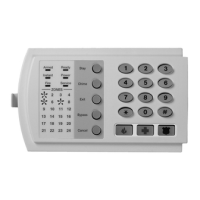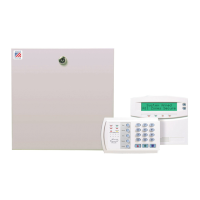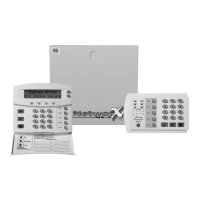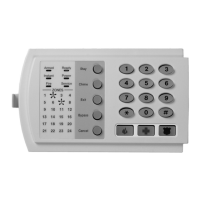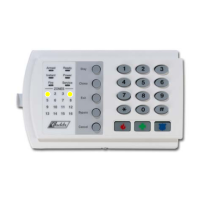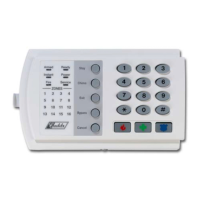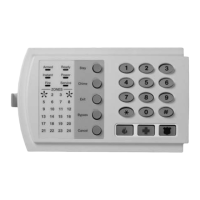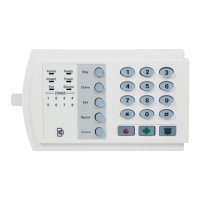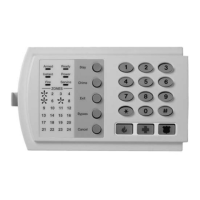
Do you have a question about the GE NetworX NX-4 and is the answer not in the manual?
| operating power | 16.5 VAC 25, 40, or 50 VA Transformer |
|---|---|
| auxiliary power with 25 VA transformer | 12 VDC Regulated 500 mA |
| auxiliary power with 40 or 50 VA transformer | 12 VDC Regulated 1 AMP |
| loop resistance | 300 Ohms Maximum |
|---|---|
| loop response | 500mS |
| operating temperature | 32 to 120 degrees F |
| led keypad dimensions | 6.4" Wide, 4.0" High, 1.1" Deep |
|---|---|
| nx-148e lcd keypad dimensions | 6.4" Wide, 5.3" High, 1.0" Deep |
| metal enclosure dimension | 9.25" Wide, 8.25" High, 3.50" Deep |
Details part numbers for system components and accessories.
Key operational guidelines and system limitations during installation and use.
Instructions for physically mounting the control panel circuit board within its enclosure.
Allows canceling alarm transmission within a set delay time.
Enables reporting of power or battery issues to the central station.
Configures audible alerts on keypads for power or low battery conditions.
Defines user codes for arming and disarming the security system.
Allows the system to arm automatically at a scheduled time.
Enables automatic bypassing of interior zones or making entry zones instant.
Automates the cancel/abort function, removing the need for button presses.
Schedules automatic communicator tests to the central station.
Describes programmable outputs for activating relays or LEDs.
Details the "Service" LED illumination for over-current conditions.
Describes the input for a tamper switch on the control panel enclosure.
Features a built-in siren driver that can be configured for voltage output.
Allows users to toggle zone bypass status with the [Bypass] key.
Enables a callback to the computer before initiating a download.
Allows canceling an alarm report within a specified time after disarming.
Requires codes for zone bypassing or initiating downloads.
Supports various reporting formats like Contact ID and SIA.
Provides 20 programmable groups for zone function and reporting.
Requires multiple zone trips within a time limit to report an alarm.
Enables sending reports to three different phone numbers for events.
Sends a duress signal when the panel is armed/disarmed with a specific code.
Performs battery tests at set intervals or upon arming/disarming.
A low-level arming mode to reduce false alarms with occupied premises.
Reports an "Exit Error" if an entry/exit zone is faulted at exit delay expiration.
Reports expander trouble and illuminates the "Service" LED.
Reports failure to communicate and illuminates the "Service" LED.
Verifies fire alarms by requiring multiple smoke detector trips.
Allows arming with violated zones, bypassing them later.
Enables bypassing a designated group of zones before arming.
Controls alarm/restore reports sent immediately or after siren time.
Stores up to 185 events with date and time for later review.
Three keypad panics (Fire, Medical, Panic) send reports to the central station.
Allows programming the keypad sounder for specific events.
Disables keypad and reports tamper after excessive invalid code entries.
Extinguishes keypad LEDs after a period of inactivity.
Disables programming of locations from the keypad.
Sends a report when the event log is full.
Illuminates "Service" LED for invalid clock time due to power loss.
Performs bell/communicator tests via keypad input.
Allows disabling on-board zones for a wireless-only system.
Details the code used to enter programming mode and its dual use.
Provides a one-button feature to quickly arm the system.
Reports an alarm within 2 minutes of arming.
Allows restarting the exit delay without disarming.
Turns off keypad LEDs and disables keypresses.
Configures siren blasts for arming, exit delay, or closing reports.
Monitors the siren circuit and reports if wires are cut.
Silences the exit delay by pressing [*]-[Exit].
Reports when programming or download sessions start/end.
Automatically bypasses zones after a specified number of alarms.
Controls whether the fire siren is temporal or continuous.
Requires two calls to defeat an answering machine.
Enables zone testing with audible feedback and local reporting.
Reports wireless sensor status and illuminates "Service" LED.
Beeps keypad sounder when arming if a zone is bypassed.
Allows using four zones as eight normally closed zones with additional devices.
Configures keypad features and behaviors via specific key codes.
Assigns a unique number (1-8) to each keypad for supervision.
Sets time increments for the last system autotest.
Allows setting the current system date on the keypad.
Allows setting the current system time on the keypad.
Procedure to access system programming using specific key codes.
How to select the specific module (e.g., control panel) for programming.
Steps for entering data into specific programming locations and segments.
How to save data and exit a programming location.
Procedure to exit programming mode after all changes.
Explains entering numerical values using keypad LEDs and segments.
Illustrates entering numerical data using keypad LEDs.
Demonstrates enabling/disabling features using keypad selections.
Programming the primary phone number for reporting to the central station.
Programming the account code for the primary reporting phone number.
Selecting the reporting format for the primary phone number.
Setting dial attempts and backup control for the primary phone number.
Selecting specific events to report to the primary phone number.
Selecting specific events to report to the secondary phone number.
Selecting specific events to report to the tertiary phone number.
Event code for zone restore in 4+2 format.
Event code for zone bypass in 4+2 format.
Event code for zone tamper in 4+2 format.
Event code for zone trouble in 4+2 format.
Event code for sensor low battery in 4+2 format.
Event code for sensor missing in 4+2 format.
Event code for duress in 4+2 format.
Event code for Keypad Aux 1 in 4+2 format.
Event code for Keypad Aux 2 in 4+2 format.
Event code for Keypad Panic in 4+2 format.
Event code for keypad tamper in 4+2 format.
Event codes for box tamper and restore in 4+2 format.
Event code for Group 1 in Contact ID or SIA reports.
Selects characteristics for Group 1 zone types.
Lists default zone types and their characteristics for system configuration.
Lists device numbers reported for expander trouble for keypads.
Lists device numbers for remote power supply expander trouble.
Lists device numbers for wireless receiver expander trouble.
Specifies maximum wire lengths for keypads based on wire gauge.
States product's compliance with relevant EU directives.
Declares compatibility with various PSTN networks and potential adjustments.
Notes approval for pan-European PSTN connection and potential country-specific issues.
Details voltage adjustment capabilities and fuse type for the device.
Specifies requirements for connecting equipment to the telephone network.
Outlines telephone company actions regarding harm to the network.
Steps to take if the equipment fails to operate properly.
Specifies minimum requirements for UL-compliant system installations.
Details features and their compliance status with SIA CP-01 standards.
